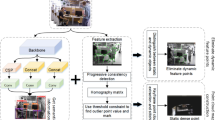Abstract
The reference map for a given environment is one of the most essential elements for a mobile robot to automatically control itself and find a path. Simultaneous localization and mapping (SLAM) is a technology that aids the autonomous movement of a mobile robot in a given environment by simultaneously creating a map and performing localization. Graph-based SLAM is the state-of-the-art solution. However, graph-based SLAM faces certain problems when constructing graphs because of the front-end processing failure that occurs when using Iterative Closest Points (ICP). When the robot is in motion, a deviation between the scan images of the environment appears in every scan. Therefore, it is necessary to perform matching of the two images by using an outlier rejection algorithm for a robust ICP algorithm. In this paper, we propose an ICP outlier rejection scheme to compare to scan images and select matching points and reject mismatched parts. The experimental results show that the proposed scheme is reliable and robust in practical environments.














Similar content being viewed by others
References
Smith, R. C., & Cheeseman, P. (1986). On the representation and estimation of spatial uncertainty. The International Journal of Robotics and Research, 5(4), 56–68.
Smith, R., Self, M., & Cheeseman, P. (1990). Estimating uncertain spatial relationships in robotics. In I. J. Cox & G. T. Wilfong (Eds.), Autonomous robot vehicles (pp. 167–193). Berlin: Springer.
Leonard, J. J., Durrant-Whyte, H. F., & Cox, I. J. (1992). Dynamic map building for an autonomous mobile robot. The International Journal of Robotics Research, 11(4), 268–298.
Doucet, A., Freitas, N. d., Murphy, K., & Russell, S. (2000). Rao-Blackwellised particle filtering for dynamic bayesian networks. In UAI’00 Proceedings of the Sixteenth Conference on Uncertainty in Artificial Intelligence, San Francisco, CA, USA.
Murphy, K. P. (1999) Bayesian map learning in dynamic environments. In Advances in Neural Information Processing Systems, Denver, CO, USA.
Montemerlo, M., Thrun, S., Koller, D., & Wegbreit, B. (2002). ‘FastSLAM: a factored solution to the simultaneous localization and mapping problem. In National Conference on Artificial Intelligence, Edmonton, Canada.
Lu, F., & Milios, E. (1997). Globally consistent range scan alignment for environment mapping. Autonomous Robots, 4, 333–349.
Thrun, S., & Montemerlo, M. (2006). The graph SLAM algorithm with applications to large-scale mapping of urban structures. International Journal of Robotics Research, 25(5–6), 403.
Grisetti, G., Kummerle, R., Stachniss, C., & Burgard, W. (2010). A tutorial on graph-based SLAM. IEEE Intelligent Transportation Systems Magazine, 2(4), 31–43.
Olson, E., & Agarwal, P. (2013). Inference on networks of mixtures for robust robot mapping. The International Journal of Robotics Research, 32(7), 826–840.
Sunderhauf, N., & Protzel, P. (2012) ‘Switchable constraints for robust pose graph SLAM. In IEEE/RSJ International Conference on Intelligent Robots and Systems, Vilamoura, Algarve, Portugal.
Lee, G. H., Fraundorfer, F., & Pollefeys, M. (2013) “Robust pose-graph loop-closures with expectaion maximization. In 2013 IEEE/RSJ International Conference on Intelligent Robots and Systems, Tokyo, Japan.
Besl, P., & McKay, N. (1992). A method for registration of 3-d shape. IEEE Transations on Pattern Analysis and Machine Intelligence, 14(2), 239–256.
Pavlov, A. L., Ovchinnikov, G. V., Yu Derbyshev, D., Tsetserukou, D., & Oseledets, I. V. (2018) AA-ICP: iterative closest point with anderson acceleration. In 2018 IEEE International Conference on Robotics and Automation(ICRA), pp. 21–25.
Censi, A. (2008) “An ICP variant using a point-to-line metric. In Proceedings of the IEEE International Conference on Robotics and Automation (ICRA). Pasadena, CA.
Segal, A., Haehnel, D., & Thrun, S. (2009) “Generalized-ICP. In Proceedings of Robotics: Science and Systems.
Chetverikov, D., Svirko, D., Stepanov, D., & Krsek, P. (2002) The trimmed iterative closest point algorithm. In Proceedings of the International Conference on Pattern Recognition (ICPR), pp. 11–15.
Ridene, T., & Goulette, F. (2009) Registration of fixed-and-mobile-based terrestrial laser data sets with DSM. In IEEE International Symposium on Computational Intelligence in Robotics and Automation (CIRA), pp. 375–380.
Xu, G., Du, S., & Xue, J. (2016) Precise 2d point set registration using iterative closest algorithm and correntropy. In International Joint Conference on Neural Networks (IJCNN).
Bentley, J. L. (1975). Multidimensional binary search trees used for associative searching. Communications of the ACM, 18(9), 509–517.
Du, S., Zheng, N., Ying, S., & Liu, J. (2010). Affine iterative closest point algorithm for point set registration. Pattern Recognition Letters, 31(9), 791–799.
https://www.robotnik.eu/mobile-robots/rb-1-base/. Accessed 17 June 2019.
https://www.sick.com/us/en/detection-and-ranging-solutions/2d-lidar-sensors/nav3xx/c/g91916. Accessed 17 June 2019.
Acknowledgements
This work was carried out with the support of “Cooperative Research Program for Agriculture Science and Technology Development (Project No. PJ01386005)” Rural Development Administration, Republic of Korea.
Author information
Authors and Affiliations
Corresponding author
Additional information
Publisher's Note
Springer Nature remains neutral with regard to jurisdictional claims in published maps and institutional affiliations.
Rights and permissions
About this article
Cite this article
Jo, J.H., Moon, Cb. Development of a Practical ICP Outlier Rejection Scheme for Graph-based SLAM Using a Laser Range Finder. Int. J. Precis. Eng. Manuf. 20, 1735–1745 (2019). https://doi.org/10.1007/s12541-019-00175-0
Received:
Revised:
Accepted:
Published:
Issue Date:
DOI: https://doi.org/10.1007/s12541-019-00175-0



